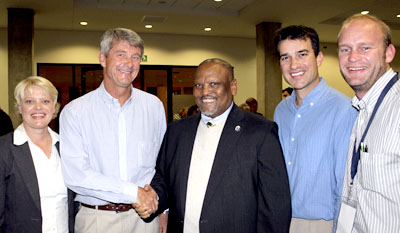Latest News Archive
Please select Category, Year, and then Month to display items
05 June 2018
Photo Supplied
 Archaeological excavations in the Wonderwerk Cave, north of Kuruman in the Northern Cape.
Archaeological excavations in the Wonderwerk Cave, north of Kuruman in the Northern Cape.
Research fellow Dr Lloyd Rossouw from the Department of Plant Sciences at the University of the Free State (UFS) recently published an article in the Nature Ecology and Evolution journal with Dr Michaela Ecker from the University of Toronto as lead author, and Dr James Brink, research fellow at the UFS Centre for Environmental Management. The findings described in “The palaeoecological context of the Oldowan-Acheulean in southern Africa” provides the first extensive paleoenvironmental sequence for the interior of southern Africa by applying a combination of methods for environmental reconstruction at Wonderwerk Cave, which have yielded multiple evidence of early human occupation dating back almost two million years ago.
Where water once was
The Wonderwerk Cave is found north of the Kuruman hills (situated in Northern Cape) a 140m long tube with a low ceiling. The surroundings are harsh. Semi-arid conditions allow for the survival of only hardy bushes, trees, and grasses. But during the Early Pleistocene, stepping out of the Wonderwerk Cave you would have been greeted by a completely different site, the researchers found. Using carbon and oxygen stable isotope analysis on the teeth of herbivores (Dr Ecker), fossil faunal abundance (Dr Brink), as well as the analysis of microscopic plant silica remains (phytoliths) excavated from fossil soils inside the cave (Dr Rossouw), the results show that ancient environments in the central interior of southern Africa were significantly wetter and housed a plant community unlike any other in the modern African savanna.
What difference does it make?
While East African research shows increasing aridity and the spread of summer-rainfall grasslands more than a million years ago, the results from this study indicate an interesting twist. During the same period, shifts in rainfall seasonality allowed for alternating summer and winter-rainfall grass occurrences coupled with prolonged wetlands, that remained major components of Early Pleistocene (more or less the period between one and two million years ago) environments in the central interior of southern Africa. That means our human ancestors were also living and evolving in environments other than the generally accepted open, arid grassland model.
'Physical education at school level important,' says Minister
2010-09-16
 |
|
At the conference were, from the left: Monique de Milander, Prof. Johan Bloemhoff, Rev. Makhenkesi Stofile, Emile Langeveld and Riaan Schoeman.
|
A record number of four staff members from the Department of Exercise and Sport Sciences at the University of the Free State (UFS) presented papers at the South African Sport and Recreation Conference (SASreCon). This conference was presented by Sport and Recreation South Africa (SRSA) from the National Department of Sport and Recreation. This is South Africa’s primary national conference on sport and exercise science.
The conference, that was hosted by the University of KwaZulu-Natal in Durban with the theme Sport, Recreation and Physical Education – An Essential Triad, highlighted the important triangular relationship between sports science, recreation and physical education. A host of leading South African and international speakers presented papers on key topics that are relevant to the South African sports and exercise landscape.
The four staff members who attended also had the opportunity to meet the Minister of Sport and Recreation, Rev. Makhenkesi Stofile. The Minister reiterated the importance of physical education at school level to ensure that South Africa can compete against the best in the world at stadiums such as the iconic Moses Mabhida Stadium, where the function was hosted.